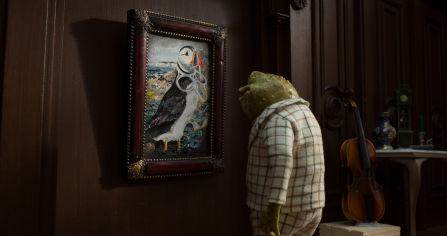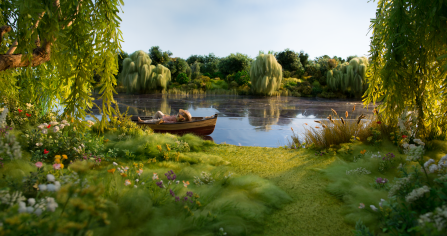Sir David Attenborough, Stephen Fry, Catherine Tate, Alison Steadman and Asim Chaudhry have backed a new campaign from The Wildlife Trusts that calls for a wilder future and for nature’s recovery in the UK. The conservationist and actors have starring roles in a new The Wind in the Willows film trailer which brings to life the 21st century threats facing the much-loved characters from Kenneth Grahame’s children’s classic. The animated trailer calls on everyone to help bring our wildlife back before it’s too late, so that we can all enjoy a wilder future.
Badger, Ratty, Mole and Toad strike out for a wilder future
The film trailer shows how the lives of Badger, Ratty, Mole and Toad are disrupted by roads, river pollution and intensive agriculture – many habitats have been destroyed and others have been broken up. Toad hangs a picture of a puffin entangled in plastic on the wall in Toad Hall. “Farewell old friend” he says.

Kenneth Grahame wrote Wind in the Willows just over a hundred years ago. Since then, many of the UK’s wild places and the plants and animals that depend on them have been lost. For example: 97% of lowland meadows and the beautiful wildflowers, insects, mammals and birds that they supported have disappeared; 80% of our beautiful purple heathlands have vanished – with their blaeberries, sand lizards and the stunning nocturnal birds, nightjars. Rivers are in deep trouble too: only 20% are considered as healthy and 13% of freshwater and wetland species in Great Britain are threatened with extinction.
Kenneth Grahame’s Ratty – the water vole – is the UK’s most rapidly declining mammal and has been lost from 94% of places where it was once prevalent, and its range is continuing to contract. Toad is also finding that times are very tough: he has lost nearly 70% of his own kind in the last 30 years alone – and much more than that in the last century.
These losses have led to the UK becoming one of the most nature-depleted countries in the world.
Over the past ten years there have been numerous reports and studies documenting wildlife declines in the UK. The main problems for wildlife are:
Habitat loss – mostly caused by intensive farming, inappropriate development and lack of strategic planning, with the few remaining wild places being broken up by roads.
Climate change – which is making a bad situation worse by causing extreme weather. This disrupts breeding patterns, threatens life cycles and creates food shortages. Wildlife cannot always keep up with changes to the seasons.
Stephanie Hilborne, CEO of The Wildlife Trusts, says:
“We are a nation of nature-lovers, yet we live in one of the most nature-depleted countries in the world. If we want to put nature into recovery we have to create a mass movement of people calling for change. Our film is a sad version of Wind in the Willows – showing how Ratty and Toad have hit the buffers – but it ends with a message of real hope. It’s not too late to create strong laws which will help our wildlife make a comeback – and it’s not too late to establish a Nature Recovery Network which will enable us to plan a wilder future.”

What does the decline look like in Derbyshire?
Derbyshire is a country renowned for its beauty. With majestic rivers, striking dales, moors, wooded valleys and uplands. Derbyshire should be a county absolutely teaming with wildlife.
But it's not. Wildlife is in decline and year after year we are seeing once common species becoming rarer.
In recent years, in Derbyshire alone, we've seen:
- 44 Local Wildlife Sites damaged or destroyed since 2008
- 200 Local Wildlife Sites in decline due to unfavourable management
- 80 Local Wildlife Sites threatened by development
- 15 of these to be destroyed or damaged by HS2
Your support is vital
Stand up for a Wilder Future and help create a Wilder Derbyshire by contacting your MP, making a donation to help us continue our important work and becoming a member, standing side by side for a Wilder Future for years to come.
